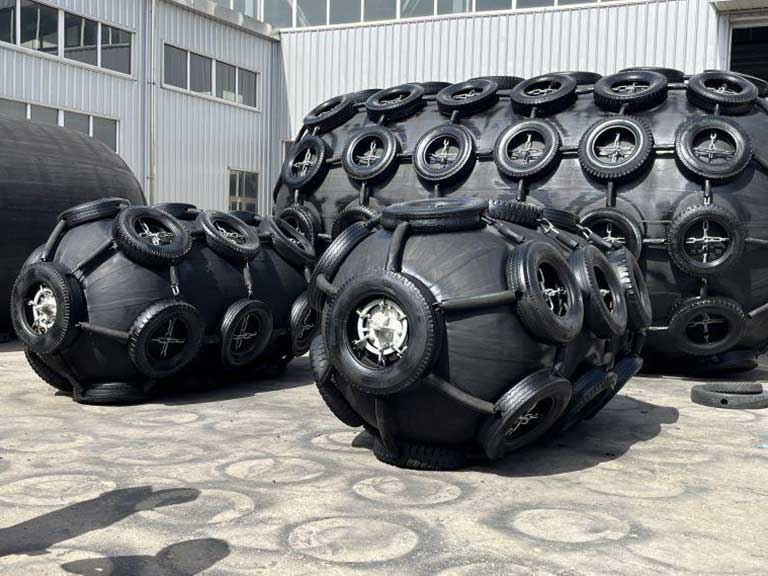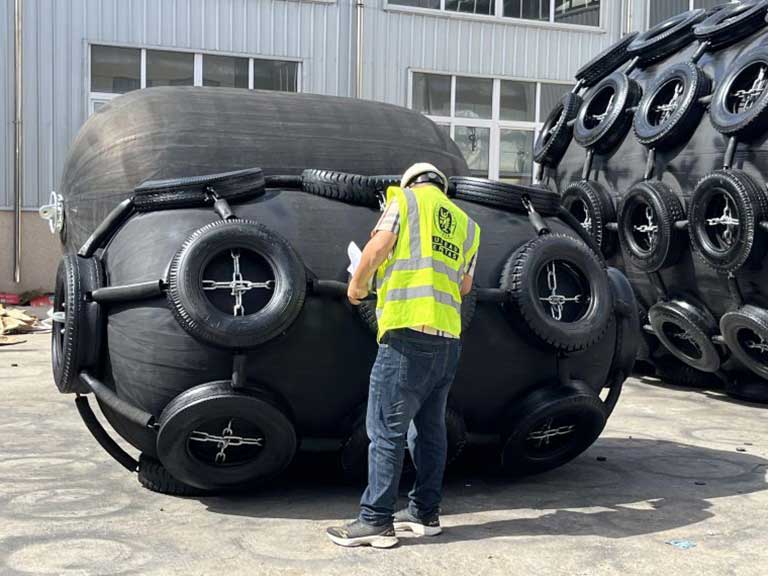Understanding the material composition of pneumatic fenders is critical for procurement decisions and ongoing maintenance. Pneumatic rubber fenders are widely used in the shipping industry due to their excellent impact resistance and durability. They are key tools for ship berthing and dock protection.
By understanding these material properties, you will be able to better appreciate the advantages of pneumatic fenders. This will enable you to make informed decisions during the procurement and maintenance processes. This article explores the primary materials used in pneumatic fenders, highlighting their advantages.
Table of Contents
Understanding Pneumatic Fenders
Pneumatic fenders are important safety devices used to prevent collisions in many maritime applications. They float on the water and absorb shock. This is because they are made of synthetic cord-reinforced rubber and are stuffed with compressed air.
Key aspects of pneumatic fenders include their primary function as floating shock absorbers and how they differ from other types of fenders. In addition, we should also understand their working principle based on compressed air inside synthetic cord-reinforced rubber.
Core Pneumatic Fenders Materials
High-performance inflatable fenders require robust materials to function properly in harsh marine environments. We use synthetic-cord-reinforced rubber sheets that are filled with compressed air. This lets them rise on the water’s surface and absorb shocks during ship-to-ship transfers and dock-to-ship berthing and docking operations.
Synthetic-Cord-Reinforced Rubber: Synthetic-cord-reinforced rubber is very strong and lasts a long time, which makes it perfect for air fenders. The extra support makes sure that the fenders can handle the high loads and forces of the sea.
High-Quality Rubber Compounds: When making pneumatic bumpers, high-quality rubber materials are used. This is because they are more resistant to wear and damage. These substances are very important for how long the fenders last and how well they work.
Due to its manufacturing process, synthetic cord-reinforced rubber is ideal for use in areas subject to high pressure. By combining these materials, we are able to produce durable, flexible pneumatic fenders. These fenders are capable of absorbing a significant amount of impact energy, thereby protecting ships and docks. At Henger Shipping Supplies, we only use high-quality materials. This ensures that our pneumatic fenders perform well and are durable.

Construction Layers of Pneumatic Fenders
Pneumatic fenders are made up of several important layers that work together to make them work well. All of these layers work together to give the fenders the strength, longevity, and usefulness they need.
Outer Layer Composition: The top rubber layers of pneumatic fenders are made to protect against damage from the elements and wear and tear. The high-quality rubber materials used to make these layers can stand up to the rough conditions found in marine settings.
Reinforcement Layers: The synthetic tire cord layer reinforces the inner sidewall. This makes the structure more stable and extends its service life. These cord layers are critical for maintaining the shape and performance of the fender under various loads.
Inner Layer Functionality: The inner rubber layers are very important for keeping air in the fender and keeping its inflatable qualities. The purpose of these layers is to keep air out, which stops leaks and makes sure the hood works for a long time.
During the vulcanization process, these layers are joined together to make a strong structure. This multi-layer structure is key to the pneumatic fender’s ability to maintain excellent performance and long service life in harsh marine environments.

ISO 17357 Compliance Requirements
ISO 17357 is the standard that governs pneumatic fenders. It lists important requirements for material and function. As one of the biggest companies that makes marine tools. Henger Shipping Supplies knows how important it is to follow this worldwide standard.
The ISO 17357 standard sets specific requirements for the materials that must be used. This ensures that pneumatic fenders are safe, reliable, and perform well. These standards include rigorous testing methods. For example, pressure testing, performance checks, and material quality assessments.
The way our pneumatic fenders are made makes sure they meet or go beyond these foreign standards. To make sure they meet ISO 17357 standards, we make sure that our goods go through a lot of testing and review. By following the rules set by ISO 17357, we make sure that ships and port facilities can operate more safely and reliably.

Material Performance Characteristics
How well pneumatic fenders work depends a lot on the materials that were used to make them. Especially how well they absorb energy.
Energy Absorption Properties: Pneumatic fender materials can easily convert kinetic energy into compressive energy. This reduces the impact force experienced by ships when berthing. It is crucial to understand how fender materials affect their ability to withstand impact without breaking.
Reaction Force Capabilities: Different types of rubber have completely different reaction forces. This has a significant impact on the forces exerted on ships when moored. We discussed how material selection directly affects the performance indicators of pneumatic fenders. For example, the distribution of reaction forces.
Understand how energy is absorbed and the reaction force that pneumatic fender materials can withstand. This will help us develop and manufacture fenders that meet customer needs. In order to make our air shields work better. Henger Shipping Supplies improves the way the materials are mixed.
| Diameter x Length (mm) | Initial Internal Pressure (kPa) | Energy (kJ) | Reaction (kN) | Hull Pressure (kPa) |
| 1000 x 2000 | 50 | 120 | 250 | 150 |
| 1500 x 3000 | 60 | 250 | 400 | 200 |
| 2000 x 4000 | 70 | 400 | 600 | 250 |

Pressure Specifications and Material Durability
The design of pneumatic fenders allows them to operate within a specific pressure range. This ensures that they function properly and are durable. The pressure limits of these shields are very important for how long the material lasts and how well they work overall.
Standard Pressure Ratings: We make pneumatic fenders that can withstand up to 50kPa (pneumatic50) or 80kPa (pneumatic80) of starting pressure. These standard pressure values affect how well the fenders work and are very important for choosing the right materials.
Safety Valve Integration: When fenders with widths of 2500mm or more are over-compressed, safety valves let out the extra air inside. This feature keeps the material from breaking and makes sure the hood lasts a long time.
The table below shows how internal pressure, endurable pressure, safety-valve setting pressure, and hydraulic test pressure are related to each other:
| Pressure Type | Description | Value/Setting |
| Initial Pressure | Initial inflation pressure | 50kPa or 80kPa |
| Internal Pressure | Pressure inside the fender during use | Varies with compression |
| Endurable Pressure | Maximum pressure the fender can withstand | As per ISO17357:2002 |
| Safety-Valve Setting Pressure | Pressure at which the safety valve opens | Set according to ISO17357:2002 |
| Hydraulic Test Pressure | Pressure applied during hydraulic testing | As specified in ISO17357:2002 |
At Henger Shipping Supplies, we make sure that our materials can handle the pressure levels that are given for the entire life of the fender. This is how we make sure that our pneumatic rubber fenders are reliable and long-lasting.

Auxiliary Materials
Chains and Tire Nets: Pneumatic fenders are usually equipped with chains and tire nets. This enhances wear resistance and impact resistance. Chains are usually made of galvanized or stainless steel, which has excellent corrosion resistance. Tire nets provide an additional layer of protection, reducing damage caused by friction.
Reinforcement Layers and Protective Coatings: Synthetic fiber reinforcement materials and multi-layer rubber structures are commonly used. This can further enhance the structural strength of pneumatic fenders. In addition, applying a protective coating to the surface of the fender can enhance its wear resistance and corrosion resistance. This helps to extend the service life of the fender and reduce maintenance costs.
Conclusion
High-strength synthetic rubber and polymer composite materials are renowned for their excellent resistance to aging and corrosion. They can significantly extend the service life of fenders. In addition, material selection should take into account the specific requirements of the operating environment, such as UV intensity and temperature fluctuations. This ensures the long-term reliability of pneumatic fenders under harsh conditions.
As a manufacturer of pneumatic fenders, Henger is committed to providing customers with high-quality, durable, and stable fender products. By carefully selecting materials and employing advanced manufacturing processes, our fenders maintain excellent protective effects in various marine environments. We are dedicated to continuously optimizing our products to meet customer needs in practical applications, providing long-term safety assurance. Whether for ship docking or dock protection, our products undergo rigorous testing to ensure their reliability.

FAQ
What are the primary materials used in manufacturing pneumatic fenders?
We use high-quality rubber compounds and synthetic cord-reinforced rubber. This ensures the durability and performance of pneumatic fenders.
How do pneumatic fenders absorb energy during berthing or ship launching?
Pneumatic fenders absorb energy through compression and utilize rubber and cord reinforcement layers to disperse force. This reduces the reaction force acting on the ship or structure.
What is the significance of initial pressure in pneumatic fenders?
Initial pressure is crucial as it affects the fender’s energy absorption capacity and reaction force. We ensure our fenders are manufactured with the appropriate initial pressure to meet specific application requirements.
Are pneumatic fenders compliant with international standards?
Yes, our pneumatic fenders comply with ISO 17357 requirements. This ensures that they meet strict international quality, performance, and safety standards.
How do I determine the correct size and type of pneumatic fender for my application?
The correct size and type depend on factors such as vessel size, berthing velocity, and water conditions. We recommend consulting our technical experts to determine the most suitable fender for your specific needs.
What maintenance is required for pneumatic fenders?
Our pneumatic fenders are designed for low maintenance. It is recommended to check regularly for damage or wear and tear, and to check the pressure. This will ensure optimal performance and extend the service life.

